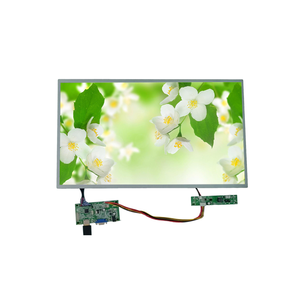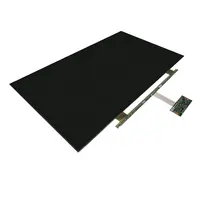
4.3-inch LCD Module LCD Screen Capacitance Touch Screen Adaptive Raspberry Pie Control Panel RGB HD 800*480 Display


High Brightness 21.5 Inch 1920*1080 Lvds 1500 Nits 72 Color Gamut Wide/normal Temp Touch Panel IPS Tft Lcd With Driver Board























In an age where visual communication is paramount, the choice of an LCD panel can make or break the effectiveness of digital displays in commercial environments. This article delves into the intricate world of LCD technology, guiding commercial buyers through the nuances of panel types, features, and build quality to ensure informed decisions that marry reliability with clarity. From the evolution of LCDs to the diverse offerings on our platform, we explore the critical considerations that can enhance the performance and impact of your commercial displays.

LCD, or Liquid Crystal Display, is a prevalent display technology used in a wide array of devices, from televisions and computer monitors to mobile phones and tablets. Unlike the older CRT monitors that used electron beams, LCDs operate with a backlight that illuminates individual pixels arranged in a grid. Each pixel consists of sub-pixels in red, green, and blue that can be controlled to create various colors. The construction of an LCD involves a layer of liquid crystal material placed between two electrodes, typically made of transparent Indium Tin Oxide (ITO), and flanked by polarizers that filter light in specific ways.
The functioning of LCDs is rooted in the manipulation of light through these liquid crystals. In the absence of an electrical field, the molecules of the liquid crystal twist, polarizing light in a way that it cannot pass through the second polarizer, rendering the pixel dark. When an electric field is applied, the molecules align to allow light to pass through, making the pixel appear bright. This method of controlling light ensures that LCDs are energy-efficient, as they use electric fields rather than currents.
There have been significant advancements in LCD technology to overcome initial limitations. The evolution from passive matrix LCDs to active matrix technologies like TFT (Thin Film Transistor) and IPS (In-Plane Switching) has led to improvements in viewing angles, response times, and image quality. IPS technology, in particular, is noted for its wide viewing angles and superior display performance, making it a popular choice for high-end monitors and mobile devices.

Our platform offers a diverse range of LCD panels suitable for various applications, highlighting the versatility of these components in commercial settings. The selection includes panels suitable for standard resolution requirements as well as options for higher resolution needs, which offer enhanced brightness and are suitable for vivid displays and touch screen functionalities.
Industrial-grade LCD screens are designed for durability and performance in challenging environments. Specialized replacement panels indicate a market for large-scale display replacements. Additionally, the availability of various sizes and specifications demonstrates the breadth of customization available for different commercial uses.
For automotive applications, panels are specifically tailored to withstand the rigors of vehicle operation. The industrial sector can utilize robust options built for longevity and reliability. Moreover, the market for consumer electronics replacement parts is addressed with products showcasing the demand for repair and maintenance components in the electronics industry.
When selecting an LCD panel, understanding the panel type is crucial as it influences the monitor's performance and suitability for specific tasks. TN (Twisted Nematic) panels are known for their high responsiveness, with pixels changing state quickly, which is beneficial for moving images and provides a smoother experience in gaming. However, they have limitations in color accuracy and consistency due to restricted viewing angles, which can affect the performance even when sitting directly in front. This makes TN panels less ideal for color-critical work.
VA (Vertical Alignment) panels offer deeper blacks and higher contrast ratios due to their efficiency at blocking light from the backlight when displaying black. This results in a more atmospheric look for dark scenes and adds depth to images. VA panels have improved viewing angles and color reproduction compared to TN panels, making them better for color-critical tasks, though not as optimal as IPS panels. However, VA panels can have slower pixel responses for certain transitions, which may result in perceived blur or 'smeary' trailing during fast motion, a factor to consider for dynamic content.
Assessing the reliability of LCD panels, especially for commercial use, is crucial as it can significantly impact the total cost of ownership. A key metric to consider is the Mean Time Between Failures (MTBF), which provides an estimate of the expected operational lifespan between potential failures. Higher MTBF scores suggest a longer lifespan and greater reliability. The design of the LCD panel plays a pivotal role in its MTBF score. Panels with fewer connections inherently have fewer potential failure points, which can enhance their reliability. For instance, a reduction in the number of connectors and cables can lead to a lower likelihood of failure, as each connection represents a possible fault point.
Moreover, the build quality of the components is another factor that influences the MTBF. LCD panels that utilize robust components are less likely to fail prematurely compared to those with lower-grade materials. When considering LCD panels for commercial applications, it's advisable to inquire about the MTBF score for the specific model and size. This score can be a valuable indicator of the panel's reliability over time. It's important to note that while a higher MTBF can denote a more reliable panel, it's also essential to balance this with the overall cost of ownership, as some panels may use less durable components to reduce upfront costs but could lead to increased maintenance and replacements in the long run.
The significance of display clarity in commercial LCD panels cannot be overstated, especially when it comes to ensuring that critical information is conveyed effectively. Our industry-leading thin bezel and superior image quality LCD video wall systems exemplify this, making them an ideal choice for environments where clear and uninterrupted visuals are paramount. Similarly, our high-resolution displays with 4K capabilities and high brightness levels, along with HDR and advanced processing, are designed to deliver sharp, detailed images that stand out even in high ambient light conditions. These displays are available in sizes ranging from 75" to 100", catering to various commercial needs. Our dynamic 4K displays, available in sizes up to 98", feature multi-source viewing capabilities, ensuring that information is not only clear but also accessible from multiple inputs. The robust build and commercial-grade features of our displays, available in 65", also highlight our commitment to delivering professional-grade clarity in LCD displays.

LCD panels are complex multi-layered components, crucial in a variety of display technologies. The materials used in their construction are pivotal for their functionality and durability. Typically, an LCD panel consists of liquid crystals, indium, and a substantial amount of glass. The glass, often exceeding 80% of the panel's composition, is ground and then modified to create a nano-porous glass adsorbent. This material is noteworthy for its application in treating wastewater containing heavy metals, indicating its robustness and eco-friendly attributes.
The construction of LCD panels also involves thin-film transistors (TFTs) which include silicon and metals such as molybdenum, tantalum, copper, and titanium. Although these materials constitute a minor percentage of the panel, they are essential for the panel's operation. The panels include other layers like polarizers, sealants, and color filters, which are integral to the display's clarity and performance. The meticulous separation and extraction process used in recycling these panels underscores the high-quality materials and sophisticated technology employed in their manufacture.
Recycling processes have demonstrated that the materials used in LCD panels can be repurposed effectively. For instance, recycled liquid crystals are suitable for the production of new LCD replacement panels or smart glass, which adapts its reflective properties to control solar heat gain in buildings. The ability to recycle and reuse these materials not only speaks to their quality but also to the sustainable practices that can be incorporated into their lifecycle, making them a responsible choice for commercial applications.
Alibaba.com offers a diverse range of LCD panels suitable for various commercial applications, providing businesses with the flexibility to find displays that match their specific needs. The selection includes panels with different sizes, resolutions, and interfaces, such as the widely compatible LVDS interface and the modern MIPI interface, catering to a broad spectrum of industrial and consumer electronics. The availability of custom TFT LCD modules allows for tailored solutions, whether for automotive applications or high-definition monitors.
The platform's assortment includes LCD panels with high brightness levels, essential for outdoor or brightly lit environments, and IPS technology for superior viewing angles and color reproduction. Commercial buyers can find LCD panels with specific features like capacitive touch, high resolution, and various screen sizes, ensuring that the display quality meets the demands of their industry. With options ranging from small, custom glass panels for devices like water meters to large, high-resolution screens for digital signage and televisions, Alibaba.com stands as a comprehensive source for LCD panel procurement.
Furthermore, the site lists ready-to-ship products, which can be crucial for businesses looking to quickly replace or upgrade their LCD panels. This variety, coupled with detailed product descriptions and specifications, helps buyers make informed decisions, ensuring they acquire LCD panels that not only meet their quality standards and functional requirements but also support the longevity and reliability of their commercial projects.
Exploring real-world applications of LCD panels, we uncover several success stories that highlight the transformative impact of this technology. One such narrative involves a digital signage company that enhanced their advertising approach by integrating cutting-edge display windows, thereby revolutionizing their advertising approach. Another case features a luxury hotel where the repair of an outdoor screen not only restored the display but also reinforced the establishment's iconic image. Further, an exclusive retail store saw a significant increase in visibility after installing a high-definition display case, showcasing the potential of LCD technology in enhancing customer engagement. Lastly, a renowned museum's adoption of a transparent display screen demonstrates the versatility of LCD panels in preserving aesthetic integrity while offering modern display solutions. These instances collectively underscore the practical benefits and diverse applications of LCD panels in commercial settings.
In conclusion, the selection of an LCD panel is a decision that carries significant weight in commercial applications. From the basic understanding of LCD technology and its advancements to the detailed exploration of the types and features of panels available, it is clear that factors such as panel type, reliability, clarity, material quality, and sourcing options play pivotal roles in determining the right fit for a business's unique needs. Alibaba.com emerges as a valuable resource, offering a wide range of options to meet diverse commercial requirements. The case studies presented reinforce the transformative potential of choosing the right LCD panel, highlighting successful applications across various industries. Ultimately, the right LCD panel can elevate a brand, enhance customer interaction, and ensure the longevity of display investments, making the selection process a critical business strategy.